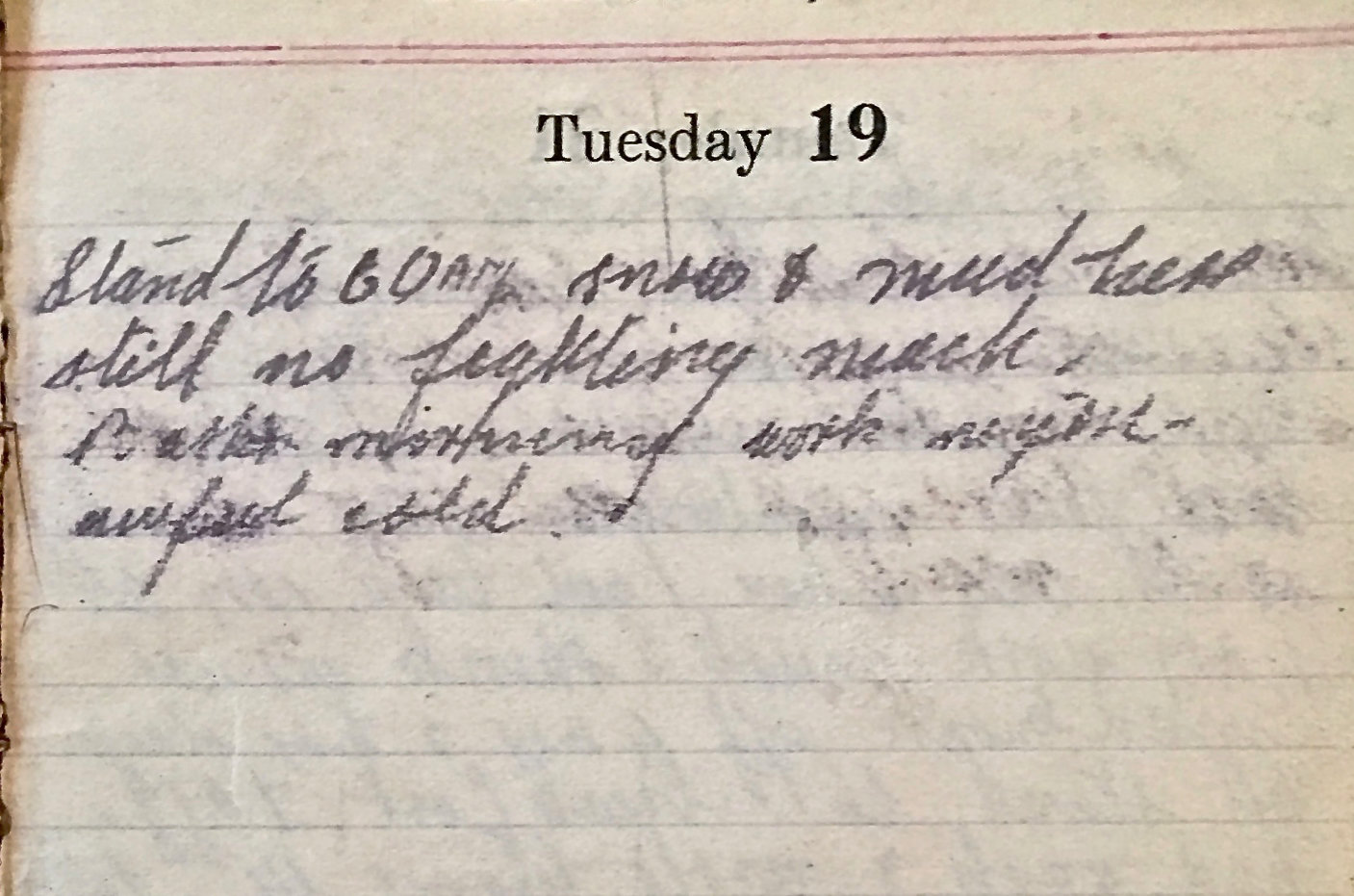Tuesday February 19th, 1918
Stand to 6am, snow and mud here still. No fighting much. Bath morning, work night. Awful cold.
Enemy Activity
Frank is back on night work and, according to the Battalion’s diary, observation of the enemy has also resumed. Singing is heard in one of the ravines and various tracks have appeared in the snow. It seems as though the Bulgarians, like the British, are busy bailing out trenches and repairing them.
Fitness for Service
You will also see in the Battalion’s diary today that a variety of soldiers are being invalided to England – some directly from the Balkans and others from Malta. On this list, two are recorded as ‘Class E’. Thanks to the experts at the Great War Forum, I can shed some light on what this means.

Before anyone could go to war, they had to have a medical inspection. Candidates were classified based upon their fitness to serve. As per Army Council Instructions, by 1st July 1916 the system was as follows:
A able to march, see to shoot, hear well and stand active service conditions. A1 were ready now; A2 ready once more training undertaken; A3 returning soldiers, ready except for their physical condition; and A4 ready once 19 years old.
B able to stand service on Lines of Communication, or in garrisons in the tropics. B1 garrison duty, labour or pioneer roles (able to shoot); B2 medical support roles, garrison duty (outdoors but non-combat); B3 only suitable for sedentary work.
C able to stand service in garrisons at home. Sub-categories as per B1,B2, B3.
D unfit but likely to become fit within six months and return to classification under A, B or C.
E unfit and unlikely to become fit within 6 months.
Commanding Officers could determine move from A2 to A1 (as military rather than health related issue). All the rest were the jurisdiction of medical staff. Although, in response to a shortage of troops, Allocation Boards were set up in Spring 1918 to ‘help’ determine categorization.
Jack Kipling
Jack had failed his medical because of his poor eyesight. His father, Rudyard Kipling, pulled some strings and Jack secured a commission with the 2nd Battalion, Irish Guards. He was killed at the Battle of Loos in September 1915 just six weeks after his 18th birthday. His parents never knew what happened to him or where he was buried (although recently discovered²). Fittingly it was Rudyard Kipling who selected the biblical phrase ‘Known unto God’ for all unknown soldiers. He also went on to write some of the most poignant war poems including ‘My Boy Jack’, ostensibly about a sailor at the Battle of Jutland (31 May / 2 June 1916), but which many observers think was more personal. It was published simultaneously in The Times (shown here), The Telegraph and The New York Times on October 19th, 1916 and subsequently renamed.
More famously in Epitaphs of the War 1914-1918:
COMMON FORM
If any question why we died,
Tell them because our fathers lied.
Interestingly in the same poem, were the following lines:
SALONIKAN GRAVE
I have watched a thousand days
Push out and crawl into night
Slowly as tortoises.
Now I, too, follow these.
It is fever, and not the fight—
Time, not battle,—that slays.
13th (Service) Battalion War Diary – 19th February 1918 – No 1 Sector, Minden Camp
Only light snowfall, visibility very good. No work on enemy trenches could be seen, and very few tracks showed up. Our artillery registered only. Enemy artillery were active in the afternoon with 77mm air bursts and mountain gun shells south of Minden and on Hampshire Ridge – apparently on communication trenches . One of our planes went over enemy lines in afternoon. The wire in front of the ruined house is six feet thick on iron posts. There are now three gaps. One where the wire crosses the road and the other two each one yard wide, five and 10 yards respectively from west edge of the road. No enemy were seen or heard there by a patrol and no footprints in the snow were seen. At 21:20 hrs sounds of singing were heard in Mansion Ravine. Following tracks were seen in the snow. 1. On south slope of Dojran Hill up Mansion Ravine. 2. Two through Dojran Town. Enemy has cleared his outposts of snow on Grand Couronne and Piton Chauve, he was also seen baling water from trenches on Grand Couronne. The following enemy wire is not shown in latest map of ‘Enemy O Trenches 1:50,000’‡: 1. New belt on south slope of Dojran Hill. 2. Two belts run from side of Lake behind ruined house at east end of Patty Ravine, joining at about point 126650 – 184375 and having a gap in south belt. From this point to east end of enemy’s main wire there is a single belt. 3. A thin belt in front of main wire of O1 from Z1-Z7. 2Lt JS Parkinson, Manchester Regt is posted to this Battalion (Auth AAG 3rd ?GHQ BSF RCK/R2/906/1822). 1 OR invalided to England from 28-1-18 and 6 OR from 2-2-18. 2 OR invalided to UK, Class E, from 31-1-18. 5 OR invalided to UK from Malta, dated 27-1-18.
References & Further Reading
‡ Sketch of Enemy Trenches South of Doiran, Digital Archive, McMaster’s University, Canada
¹ ‘Fitness Classification – Other Great War Chat‘, The Great War Forum
² ‘Solving the mystery of Rudyard Kipling’s son‘, BBC
* Q30067, Imperial War Museum



